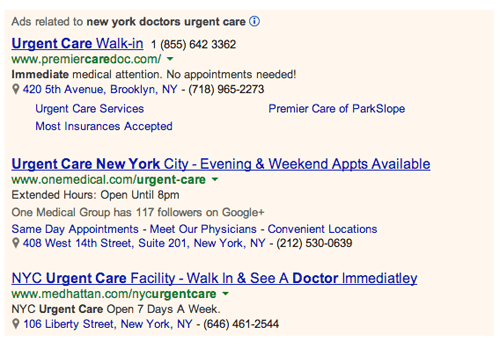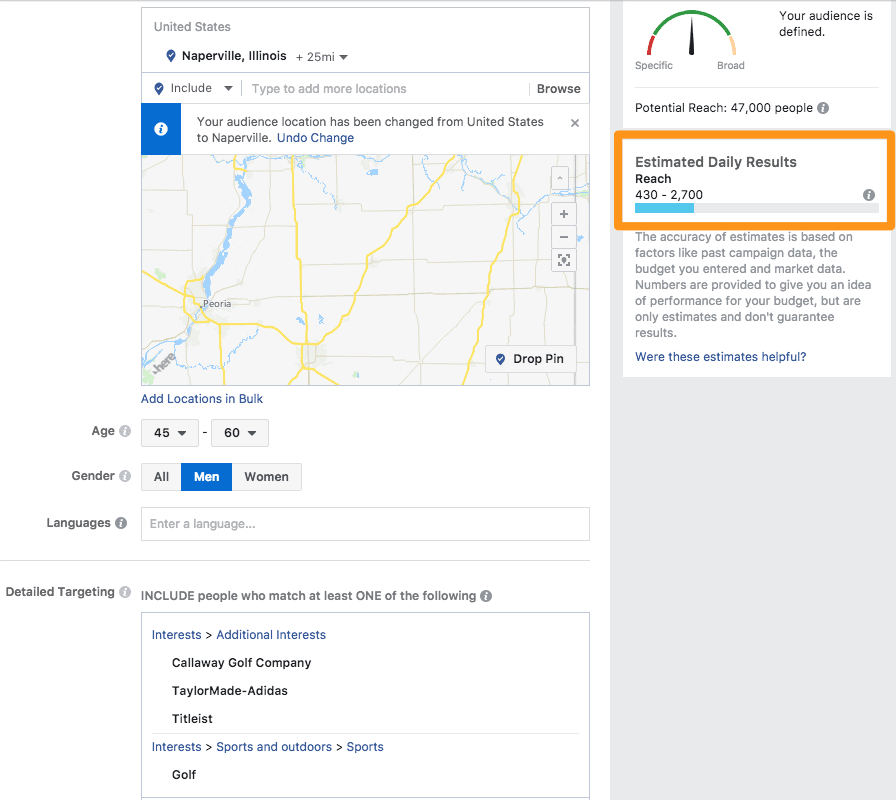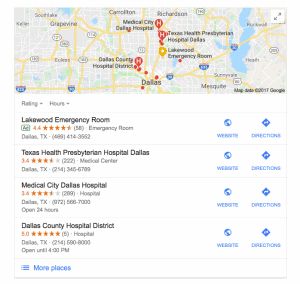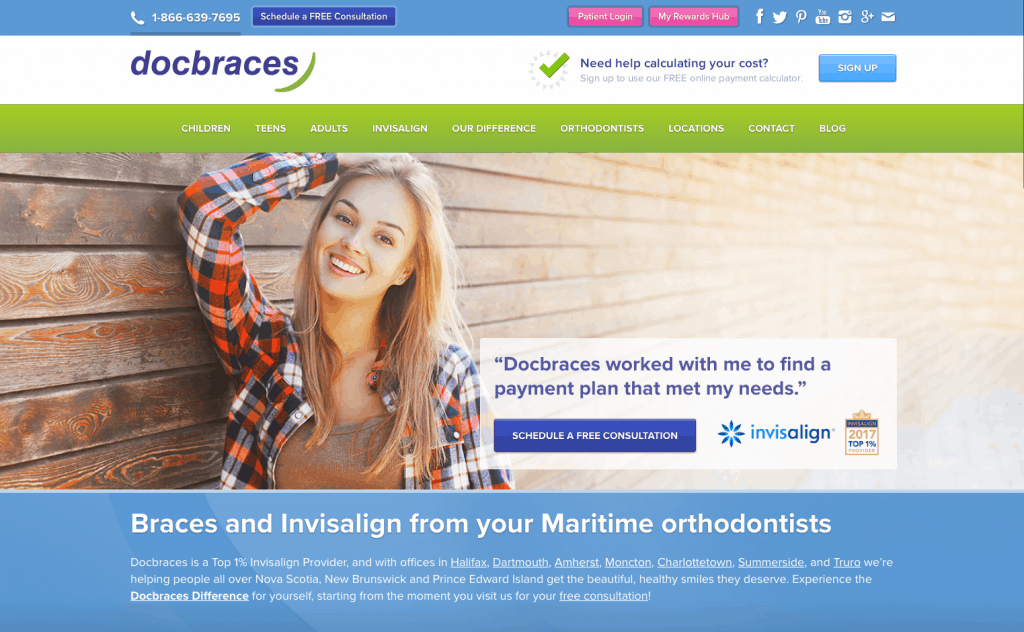
Using your website to get more patients for your practice is an underutilized marketing method by many in the healthcare industry. It is time to start taking a focused and strategic approach to the audience you’re trying to attract online to convert them into long-term patients offline eventually.

According to TeleVox, 51% of people say they’d feel more valued as a patient through digital health communications. This means that it is time to strengthen your relationships with potential patients online to ensure that awareness of your practice is reaching the most amount of relevant people as possible.
The first step to getting more patients online is to define the goals and budget for marketing ahead of time.
- Are you looking for more traffic to your website?
- Do you want your website to convert more of those website visitors into new contacts and appointments?
- Are you interested in increasing your reach on Facebook?
- Are you looking for more views on your YouTube videos?
All of these goals should be centered on getting more qualified leads to your website and, as a result, more local patients into your healthcare facility.
Secondly, set aside a significant portion of the marketing budget for online campaigns. 59% of U.S. adults have looked online for specific health information, such as what medical condition they or someone else might have, according to Pew Research.

The online presence of a healthcare facility is increasingly playing a role in research conducted by potential patients, therefore online spending should be a major focus of the overall marketing budget. This study conducted by Google and Compete highlights the growing importance of online marketing versus other channels for reaching customers during the critical research process of finding a doctor, a nursing home, a dentist, a hospital, etc.
Below are 17 marketing tactics to reach potential patients online for hospitals, health care centers, nursing homes, and other healthcare facilities.
Index of Marketing Ideas:
Social Media | Online Advertising | Search Engine Optimization (SEO) | Content Marketing | Reviews and Reputation Management | Website | Email Marketing
Social Media
What Platforms Should You Be On?
Realistically, you can’t do them all, so you want to have a primary social media channel you focus on so that you’re able to invest the time and resources to get the most out of it.
Facebook is the social media platform everyone should be on. It has over 2 billion users and it’s become ingrained in our lives and phones. It is where we go to be entertained and to learn about what our friends are doing. People of all ages are on Facebook—your patients are there, too.
1)Why should you be on Facebook?
- Your audience is on Facebook, and you need to have an active Facebook page that helps tell about your practice
- Share testimonials and create amplified word of mouth referrals
- Share content that informs and educates your patients about your specialties, but that is written in patient friendly language that they can understand in order to make a decision about what is next in their healthcare journey.
If you’re looking for content to post, start with the questions you get from patients. Cleveland Clinic reported one of their most popular Facebook posts is an infographic on the color of your urine, and what it says about your health. This may not be a topic you might expect to take off, but it did and over 2 million people have seen the Cleveland Clinic name because of it.
2) Instagram
As a second network, Instagram is huge and has 500 million people using it everyday. If your target patient demographic is younger and female, then having an Instagram strategy is a must. Instagram has a number of features that draw people to it, but one of the things I’ve noticed is that people perceive the photos and videos on Instagram as more authentic. It’s often photos of themselves, what they are doing, where they are going, and what they are eating.
So you’ll want to make sure your Instagram updates match the tone of the network. Focus your Instagram posts about your patient transformations, share before and after photos of your patients (with their permission), and talk about what they’ve accomplished. For inspiration, check out UCLA and St. Jude on Instagram.
Pro tip: Hashtags are a BIG deal on Instagram so make sure you’re using 1-3 on each post. Each hashtag you use will allow your post to be found under that hashtag, and when people look at that hashtag in search, you’ll be able increase your followers and your audience.
Hashtag ideas: if you are a dermatology practice, you could use hashtags like: #antiaging #wrinkles #botox #beauty #skincare #skintreatments #acne #acnetreatment #skincheck #melanomaawareness #clearskin #dermatology #skincare
3) Facebook Video
Over 100 million hours of video are consumed each day on Facebook and 93% are watched without sound, as it plays automatically in the newsfeed.
You might think that video is silly, or personally you may not like video at all. I understand, I’m not a huge fan of watching video either but I do find myself watching Facebook videos because they automatically start when you scroll past them in your Facebook newsfeed. Your patients will watch your videos as well.
Still not convinced?
How about an example that puts it into financial perspective? We’ve consulted with a single doctor pediatric practice who doubled his practice volume to $2.5 million a year by changing just one thing, adding video. By posting consistent videos on Facebook, explaining conditions and answering questions he gets from patients he has doubled his practice revenue and is now only taking newborns as new patients.
Action Step: Create a video thinking from a patient perspective, focusing on what it will be like on their first appointment, what your exam rooms look like, who they will meet, what they should expect. We fear the unknown, but by sharing this type of content, people are able to see and hear your doctors, your facility, and your care. Now that it’s not as unknown to them they’ll be more likely to move forward in scheduling that first appointment.
Online Advertising
Undoubtedly you’ve gotten questions and misinformation from patients who consulted Dr. Google and told you about it during an appointment. In fact according to Rock Health, 56% of patients bring in what they found online to their doctors and according to Pew Research Center, 53% of people who attempt to self-diagnose a medical condition through online information talked with a physician or medical clinician about what they found online.
This confirms that people are seeking out information about their healthcare online, and you can be there at the top when they type their question into Google by buying ads.
4) Google, Bing and Yahoo Ads- Pay Per Click Advertising
Pay per click (PPC) advertising is a marketing channel that allows organizations to pay for an ad in the search engines like Google, Bing, or Yahoo. The ad is present at the top of the search results for different groups of keywords that the advertiser specifies at the beginning of a campaign.
For instance, if an Urgent Care facility wanted to rank highly in the search engines for the keyword Urgent Care NYC then a PPC ad could do the trick.

This is often called search engine marketing (SEM) and Google AdWords and Bing Ads are the two main places to start. When someone comes to a search engine, they have search intent, meaning they are looking for help with something.
When they are looking for medical help, you can buy the space to show up as an ad, and they can click your ad and come to your website. People will search symptoms they have, prescription side effects, doctor’s names, conditions, and treatments. They are looking for information you have and if you aren’t advertising you’re missing out on those patients.
According to Geonetric, 81% of people click on a sponsored link when looking for health information, which could be crucial for gaining attention for your facility. PPC ads work well because when someone sees the ad they are actively looking for information on that product or service, which means their intent to take an action is stronger and more likely to lead to a visit to your website, as compared to seeing an ad in a newspaper or billboard.
However, it is possible to keep the keyword research process simple when deciding on what keywords to target for your PPC ads.
- Decide what keywords the marketing team thinks people would search to find your facility, like your name, services, location or any other identifiers about the organization. Make a list of these two to four word keyword phrases to test.
- Plug these keywords into the Google’s AdWord Keyword Tool (one at a time) in the word or phrase field.
- Choose exact as the match type on the left hand column before searching, to get traffic estimates for the words only in the order they were entered in.
- Then, searching each word will bring up the search traffic for that keyword and related keywords. Look at the local monthly searches and competition to determine an estimate of the traffic a group of keyword phrases could potentially drive and if there is a possibility to rank for those terms overtime. The more specific the keyword phrases, the more likely your organization can rank for them overtime. For instance, NYC Doctor is a much more difficult keyword phrase to rank for than is NYC Brooklyn Doctor.
5) Facebook Ads
Unlike Google, you can’t target exactly to people who are looking for your help, but you can target those who you THINK might be interested based on your existing patient demographics.
Facebook allows you to choose who to show ads to based on age, gender, and location, but goes beyond that to allow you to search by interests, income, job/occupation, and many other categories.
This allows your ads to be far more targeted and that increases the clicks and the performance of the ad.
How does this work? Orthopedic clinic example
Let’s say you are an orthopaedic clinic in Chicago that has opened a new location in the suburbs in Naperville, IL. You know that a good percentage of your patients are men aged 45-60 who have knee problems. Their knee problems are preventing them from playing golf as frequently as they’d like to because of the pain they experience as they walk the course and swing their driver.
You can build an audience to put ads on Facebook that targets that demographic, and because you’re able to target them specifically with that criteria you can make the ads more direct and compelling by saying “Ready to play a full 18 holes without pain?” rather than a vague “Fix your knee pain today.”
For example, we’d target them by age, gender and location, but then we’d also narrow the audience by adding interests of golf and golf related brands such as Titleist, Taylormade, and Callaway.
Here is what that audience would look like in Facebook.

As you can see in the orange box, we’d be able to have ads shown 430-2,700 people in our targeted audience each day.
6) Retargeting Ads
If you’ve ever visited a company’s website and then wondered why an ad shows up for their products on other unrelated web pages you visit, you’ve experienced retargeting ads.
These ads essentially follow people who have visited your website around the web as they browse. It takes multiple marketing messages before someone hears it, so retargeting allows you to keep up a consistent presence.
Retargeting ads are effective because you are showing someone a brand message after they’ve already expressed interest in your company by visiting your website.
The ad design and copy can be targeted to the exact page they went to, or to the overall website. Using the example of the orthopedic clinic above, if they visited the website page for knee replacement we could then show them ads about the specific topic of knee replacement instead of a more general ad just about the clinic.
You can run retargeting ads through Google, Facebook, or AdRoll.
Because the ads aren’t being shown to everyone, just the people who have visited your website, the cost can be quite affordable and effective.
Search Engine Optimization (SEO)
SEO is how you show up in Google search results without paying the companies directly for ads, and it’s also called “organic results” or “ranking in Google”. This is important because if you can’t be found in Google, to many patients it’s like you don’t exist.
77% of patients used search prior to booking an appointment says Google, but how can you reach these patients? SEO or search engine optimization is the process of optimizing a website for ranking in the search engines like Google, Bing. and Yahoo to get in front of relevant people.
SEO is different than pay-per-click advertising because rankings for different keywords are achieved overtime organically, while PPC are paid ads that can occur the moment payment is processed.
SEO and PPC can work hand-in-hand to get visibility in the search engines and gain traffic to your website from prospective patients. SEO is best compared to an oven that heats up slowly and takes a long time to cool down, since your rankings increase overtime and continue to rank for the long-term.
PPC is best compared to a microwave because it heats up right away but cools down the moment it is turned off, much like the rankings that turn on the moment they are paid for and turn off the moment they aren’t.

SEO can be broken down into two main types, Local SEO which focuses on location based search, and Organic or National SEO which is everything else. You need to be optimizing for both to rank and see an increase in new patients.
7) Local SEO
If you want your practice locations to show up on Google for your geographic region when people search “eye doctor CITY,” you need to have an optimized local search presence. The easiest way to think about it is the map results  of a Google search. Like the Olympics, only the first three results get to show up for a medal.
of a Google search. Like the Olympics, only the first three results get to show up for a medal.
5 tips to ranking at the top for local search are:
1) Make sure your information is accurate in Google My Business, including your hours of operation, your address, and phone number, this is called your Name, Address and Phone (NAP) information.
2) Add high quality photos of your office that showcase what it would look like when a patient visits.
3) Have recent positive reviews and more than your local competitors.
4) Make sure your page titles are optimized because they matter for click through rates.
5) Claim and correct local listings across the web with your NAP data
Do these steps so that you’ll show up when patients are looking for specifically where to find help, and they’ll find you.
SEO is a long-term strategy and unlike ads, the results are not immediate. However, when you stay the course and your ranking increases so that you rank in the top three, it has tremendous results for bringing in new patients. 60% of the clicks go to the top three results and you want those clicks to lead them to your practice.
Pro-tip: One of the most popular searches is the “near me” search, because sometimes you just want something close to you. They’ve skyrocketed over the last three years – make sure you’ve optimized your website on-page SEO for this.
Near Me Search terms:
“Dentist near me”
“Pharmacy near me”
What is your near me search term?
Will having good SEO bring me new patients?
YES!
Example:
We have a client who ranks in the top three in Google for key search terms and their practice gets 65-80 new patients a month from organic search on Google.
8) Organic or Natural SEO
To understand how SEO works, think of your own behavior when you are looking for information. You probably got to this article from searching keywords related to “increase patients to my practice” or something similar and this article is one of the top three articles for that search result.

Search engine optimization works really well at positioning your doctors and practice as the go-to source for information on what the patient seeking. Healthcare is one of the top consumed content online, so don’t miss the opportunity to put your doctors expertise on display.
Search engine optimization in healthcare operates on a number of factors, but they all start with your website.
5 SEO Must Haves:
1) Mobile Responsive – your site must be easily to use on a mobile phone. Not sure if you are? Use Google’s tool to check.
2) Your Site Must Be Secure – Your site receives a search boost from Google when you have HTTPS enabled, and if it isn’t your visitors could receive a warning message that will make them leave your website.

3) Your site needs to be fast—no one likes a slow loading website—and 53% of people will leave a mobile website if it is too slow to load. Use this tool from Google to test your mobile website speed.
4) Your website needs to have words and content on the pages that address how people search for help. This goes beyond just keywords but also including symptoms, conditions, and treatments.
5) Links to your website from other high-quality websites online. When a website links to your page, it’s like they are introducing you at a party. Their recommendation carries weight, so it is important to make sure you actively seek out high-quality links from others.
SEO is an ongoing process because search results are dynamic, other websites are constantly changing their content, and Google is changing its algorithm to give the best results to those who search. This means that for your website to rank well and continue to rank well, it needs to be changing and growing.
One of the most popular means of increasing search engine ranking is with a content marketing strategy, which is writing helpful articles multiple times a month (or week) so that your website is updated frequently and consistently.
As search engine optimization changes, one of the biggest changes is the number of words on a page it takes to rank first on Google. The average first page rankings have 1,890 words on the page.

I know what you are thinking, there is no way people are reading all of those words.
You’re right, they aren’t. Web users browse and scan, but Google does read all those words. The amount of words and the type of words help you stand out from other pages for that search term because it is an authority factor. If your page has 1,500 words about the symptoms of a medical condition, and the next page has 500, your page looks more authoritative to Google. It’s not the only factor, but it is an important one. For example, this blog post is 5, 406 words, but because of formatting you were able to easily scan and read it.
There are many factors that are taken into account to determine the rankings for your website by the search engines, but the top concerns of your healthcare organization should be on-page optimization and content marketing.
Succeed at these, and you’ll start seeing your rankings increase and an increase in new patient appointments.
Not sure and questioning the state of how your website performs for SEO? Get a quick SEO audit in 30 Seconds.
9) Content Marketing
Creating quality content about your expertise, industry and services is an effective means of attracting the attention of new patients and reminding existing patients of your continued value. Content marketing or content creation accomplishes three goals:

- Continual content from your website boosts SEO efforts.
- It helps create content for sharing on social media.
- Brings valuable content for readers to digest and associate with your organization.
If you haven’t already, start a blog for your organization’s website.
Start by defining what topics your content will cover and list them out in a spreadsheet. One of the best places to start is with the questions you already get from patients. If they are asking you, they are also asking Google.
Next, determine what types of content your health organization should produce to draw the attention of more patients. Start developing and gathering articles, blog posts, photos, videos, user-generated content, SlideShare presentations, ebooks, white papers, guides, studies and more to share with your audience from your perspective.
After that, determine who is going to write the content and how often you’re going to publish. If you aren’t sure, start with weekly posting. You can always increase it later, but in the meantime here’s a starting plan for weekly posting:
Weekly Posting Outline:
Week 1 – Story of how you helped a specific patient.
Week 2 – Educate about a medical condition you treat.
Week 3 – Lightweight common medical topic that relates to your overall goals (diet, nutrition)
Week 4 – Inform about a type of treatment, and why it works.
Here are examples of healthcare facilities that have successful blogs and content marketing strategies for their healthcare organization like this one from The Brigham and Women’s Hospital, IU Health, Mayo Clinic, Cleveland Clinic or Seattle’s Children.
10) Implement Reviews and Reputation Management
Reviews can be a frustrating point for a lot of practices, because it’s largely the upset patients who have left your practice who are leaving negative reviews.
You may not think your reviews online matter, because you know that you’re a great doctor, or that your practice has some of the best specialists in your region if not the nation. All of those thoughts are true, but patients will still believe a review that says, “My doctor is fantastic, but the billing department is the worst to work with,” or “Dr. Smith kept me waiting, spent 5 minutes with me and wouldn’t listen to what I had to say.”

Rock Health reports that over a third of Americans have written an online review about a specific provider.
A Pricewaterhouse Cooper survey revealed that 42% of individuals viewing health information on social media look at health-related consumer reviews and referrals of specific treatments or physicians.
Patients don’t leave your practice because they get bad medical care, they leave most often because they don’t feel cared about, or were treated well, and 30% leave because of service. Those are the topics that show up in reviews, and if 80% of your patients are satisfied, you need them leaving reviews too.
The same report, from the Altarum Institute Center for Consumer Choice in Health Care says, “43% of consumers said that they would be likely to switch doctors as a result of negative online ratings from other consumers, while only 23% of doctors thought that that would influence consumers.”
The good news is that you can help your patients leave you a consistent stream of good reviews that will outweigh the bad.
How to do this? Use an internal process or software to manage your reviews and make sure your review sites are consistently updated with positive reviews.
It’s a simple three step process to good patient reviews:
1) Prompt the patient about their experience as they leave or immediately after their appointment, either in person with a tablet or via email or text message.
2) Have them quickly rank the experience, 1-5 stars.
3) If it is a positive review, send them to Google or Healthgrades to share it. If negative, send the comment to your staff to respond and hear more about why they rated you so low.
When you manage the reviews process you’re able to reach those who were dissatisfied, but not only that you’ll start to get online reviews that match your actual patient experiences, bringing in new patients.
11) Offer Immediate Online Access – Add Live Chat
Your patients are consumers and have the expectation that they can connect with your practice whenever they want. The benefits of adding HIPAA compliant live chat to your website is that you’ll enable your patients to connect, ask questions, and come in for an appointment in real time without picking up the phone or writing an email.
You might be wondering, can’t they already do that when they call? This is true and many people want to talk on the phone, but not everyone does. Plus, no one likes being on hold and 42% say the benefit of live chat is not waiting on hold.
Wondering what they want to ask about? New patient appointment requests, questions about services or procedures, billing inquiries, and rescheduled appointments. The more friction we remove from the process, the easier it is for someone to take the next step and end up in your waiting room.
What tools should you look into? For smart live chat on your website, Path is a HIPAA compliant live chat solution, or another great option to try is Drift.
Have a Modern Website
 Having a beautiful modern website is important, but make sure that it actually helps new visitors to your website understand how you can help them. Many websites in healthcare show their building, their doctors, and patient forms, but actually fail to tell the person visiting their website how they can help them feel better or solve the pain they have. “Brand New Facility” doesn’t tell the patient who moved here from out of town that you do eye surgery, or that you’re the biggest practice by volume in the area, or that you doctors ranked best ranked in reader polls.
Having a beautiful modern website is important, but make sure that it actually helps new visitors to your website understand how you can help them. Many websites in healthcare show their building, their doctors, and patient forms, but actually fail to tell the person visiting their website how they can help them feel better or solve the pain they have. “Brand New Facility” doesn’t tell the patient who moved here from out of town that you do eye surgery, or that you’re the biggest practice by volume in the area, or that you doctors ranked best ranked in reader polls.
12) How to Have a Patient Focused Website
- Make it simple for a patient to understand how you can help them,
- Make it easy for them to say yes to being helped.
- Have a very large, colorful “Request an Appointment” or “Schedule Appointment” button on multiple places on your website.
@robbirgfeld: 80% of consumers will choose a physician with online scheduling over an identical one that does not. Wow! #HCIC17
— Ahava Leibtag (@ahaval) October 23, 2017
https://platform.twitter.com/widgets.js

When it comes to online scheduling, here’s the trick: you don’t need them to actually let them schedule in real-time, and they don’t normally need that either.
Send them to a form that has the most basic information you need to call or email them back and schedule an appointment. Let them know you process it within 24 hours and if they need an appointment within the next 24 hrs to please call at a certain number.
It’s important to understand that not all patients will do the thing we want them to do on their initial visit to your website. Of course we want them to schedule an appointment, it’s the primary action what we want them to take—”Schedule an Appointment”.
13) Offer Next Step – A Lead Generating Asset
However, many of your visitors aren’t ready to make an appointment yet, so it’s important to offer a secondary call to action so that patients have a low-risk way to continue their engagement with your brand. This call to action needs to take them to a lead generating marketing asset—such as a self-assessment, ebook, checklist, or video. These are valuable pieces of content that do two very important things:
1) Helps establish you as the authority in your field of expertise.
2) Captures an email address of a potential patient so that we can keep them aware of your practice.
What are types of lead generating assets?
- Calculator for the cost of braces for an orthodontist.
- PDF checklist for eye doctor, like “5 Tips to Picking Frames that Make You Look Your Best.”
- Ebook that educates on questions related to your area of practice—”Ultimate Guide to Eating Out After Bariatric Surgery.”
The goal of the lead generating asset is to establish you as the authority, build trust, and capture their email address so that they will be reminded of your practice as you send encouraging emails and remember you when they are ready for treatment.
Market Inside Your Office
Make sure that patients understand what else you can help them with.
14) Top 5 Ways – Marketing One Pager

No one loves more paperwork, but just imagine if you created a one page sheet that simply and clearly said, “Here are the top five reasons people come to our office and get help from us. Are there any reasons on this list that you’d like us to talk about how we could help today?”
They will fill it out in the waiting room, and when they do that they’ll process the top five ways you help other patients – helping them understand more about what other types of care they can get from you.
Due to time constraints, you may not be able to cover what they filled out in their appointment that day, but it will make scheduling they next appointment more urgent.
15) Showcase 5 Star Reviews in your Waiting Room
Reinforce your reviews INSIDE the waiting room. Make sure you’ve got some printed marketing material that showcases a recent 5-Star review in your office from a Google Review or Healthgrades Review. We want your patients to be advocates for you and showing them you are 5-Star will help them tell others about your 5-Star care.
16) Follow up with Patients (more than once a year)

Your existing patients are the foundation of future appointments, and in your patient base you’ve got thousands of appointments you miss out on each year because they just forgot to come back in. People get busy and while they are well intentioned before they know it it’s been over a year and they haven’t been back in.
Action Step:
Create a system to consistently follow-up with your patients about their care and their appointments so that this happens automatically. You could purchase a software product to do this or implement an internal system your employees follow, but make sure you get your patients coming back when they should be. It’s healthy for them and healthy for your business.
17) Stay in-front of your patients with Email Marketing
Send current and prospective patients emails at least monthly and communicate with them about relevant healthcare information that they find helpful, educational, and informative. Remember, your patients are seeking healthcare knowledge and they trust you, so help them along their healthcare journey and they’ll remember that. Use an easy to user-friendly email service provider like MailChimp, Constant Contact or iContact to create an ongoing newsletter for your healthcare facility.
As we’ve discussed, it takes long-term relationships to build a database of the right patients. Email is a vital way to strengthen relationships with potential patients, not to mention that traditional channels like direct mail often cost 20 times as much as email marketing, according to Phyzoom.
If you are writing blog posts regularly or producing video, then that content becomes great information to send them. It helps them be informed and it helps you stay top of mind.
Gather emails of existing patients in order to send them reminders of their upcoming appointments, as well as the option to sign up for a newsletter. By consistently providing valuable content to existing customers that opt into your email list will help spread word of mouth about your practice over time. This is not a given without offering your existing patients quality service, as well as original content that resonates with them. Once you’ve achieved both, email marketing will simply help boost these efforts.
Remember, the importance of online marketing versus other channels for reaching customers during the critical research process of finding a doctor, a nursing home, a dentist, a hospital, or pharmacy is only increasing as patients spend more time and effort in their healthcare journey.
What of these 17 marketing ideas will you start today to attract more patients to your practice?
Blog Post Updated: December 23rd, 2017
Images courtesy of HealthCare Communications, Google & Emily Schwarting.












